March 9, 2007
Air Date: March 9, 2007
FULL SHOW
SEGMENTS
Airline Emissions Fly High
/ Ashley AhearnView the page for this story
The airline industry makes up two percent of the world’s CO2 emissions, but at 27,000 feet in the sky those emissions pack more of a punch than they would at ground level. Living on Earth’s Ashley Ahearn reports on the industry’s slow flight to a green future. (06:00)
A Chemical Conflict of Interest?
View the page for this story
The government agency charged with evaluating the toxicity of the chemical Bisphenol A has hired a private consulting company to do the lion's share of the prep work for them. But it turns out that the consulting company's other clients include the manufacturers of the very same chemical. Los Angeles Times reporter Marla Cone joins host Bruce Gellerman to discuss the details. (05:30)
Texas Fold 'Em?
View the page for this story
Many environmentalists have hailed the recent buyout of Texas power company TXU as good for the future of green energy. But some groups are skeptical of the transaction. Host Bruce Gellerman speaks with Rainforest Action Network's Jennifer Krill about the TXU deal. (04:30)
A Bright Idea?
View the page for this story
Compact florescent light bulbs may be more efficient than incandescent lighting, but they contain toxic mercury. Terri Goldberg, deputy director of the Northeast Waste Management Officials Association, joins Bruce Gellerman to talk about the environmental impact of fluorescents and the lack of regulations for recycling the bulbs. (05:30)
Born in the U.S.A.
View the page for this story
The United States has the second worst newborn mortality rate in the developed world, despite the fact that it's one of the most expensive maternity care systems. Dr. Marsden Wagner is the former director of Women and Children's Health at the World Health Organization and he says the system is broken. Dr. Wagner joins host Bruce Gellerman to discuss his book “Born in the USA – How a Broken Maternity System Must Be Fixed to Put Women and Children First”. (08:00)
The Language of Landscape
/ John DanielView the page for this story
Living on Earth launches a new series exploring features of the American landscape. The series is based on the new book Home Ground: Language for an American Landscape, edited by Barry Lopez and Debra Gwartney. In this first installment, Oregon writer John Daniel muses on the word “cascade.” (02:45)
Wildlife Crossings
/ Gillian Ferris KohlView the page for this story
Collisions between elk and highway motorists are increasing in Arizona. Now, wildlife officials have hit on an unusual solution that grabs drivers' attention. Gillian Ferris Kohl reports. (05:00)
Sumatran Cuckoo Breaks Its Silence
View the page for this story
Bruce Gellerman talks with Peter Clyne from the Wildlife Conservation Society about the rare Sumatran Ground Cuckoo bird. (04:30)
Return of the Tibetan Antelope
/ George SchallerView the page for this story
The Chiru, or Tibetan Antelope, once roamed the Tibetan highlands in herds of a million or more. But poaching and livestock farming diminished their numbers. Wildlife biologist and adventurer George Schaller recently traveled to China’s Chang Tang region to search for Chiru and he was happy with what he found. (03:30)
Show Credits and Funders
Show Transcript
HOST: Bruce Gellerman
GUEST: Marla Cone, Peter Clyne, Terri Goldberg, Jennifer Krill, Marsden Wagner
REPORTER: Ashley Ahearn, Gillian Ferris Kohl
COMMENTATOR: John Daniel, George Schaller
[THEME]
GELLERMAN: From Public Radio International - this is Living on Earth.
[THEME]
GELLERMAN: I’m Bruce Gellerman
The number of airplanes in the sky is soaring and so are the green house gases they spew into the atmosphere. There are new jet engine technologies and cleaner fuels in the works but aviation experts predict airplane emissions are still going to taking off.
BUSHNELL: They’re talking at the most 50 percent reductions in CO2 by evolutionarily fiddling around with the current machines and that will hardly account for the expected growth in air travel.
GELLERMAN: Also a baby doctor says the baby biz needs to be fixed.
WAGNER: In our country, the obstetricians try to catch all the babies. And get all the money and all the credit. And this is a very broken way to do things.
GELLERMAN: The birth and a call for the rebirth of midwifery.
These stories and a bright idea for light bulbs this week on Living on Earth. Stick around!
[LIVING ON EARTH THEME]
ANNOUNCER: Support for Living on Earth comes from the National Science Foundation and Stonyfield Farm.
Airline Emissions Fly High

(Courtesy of NASA)
GELLERMAN: From the Jennifer and Ted Stanley Studios in Somerville, Massachusetts this is Living on Earth. I’m Bruce Gellerman, sitting in for Steve Curwood. Look up in the sky—it’s a bird, it’s a plane actually, it’s 15,000 airplanes.
That’s the number of planes flying in the air at any given time, and that doesn’t even include private jets. Government officials predict by 2025, the number of planes in the sky will soar three-fold. That’s bad news for the environment because more flights mean more global warming gases spewed into the atmosphere.
Living on Earth’s Ashley Ahearn reports cleaner fuels and aircraft are on the horizon but, like many flights, they may be delayed.
[MUSIC: Kenny Loggins “Danger Zone (Theme from ‘Top Gun’)” from ‘The Essential Kenny Loggins’ (Sony Music - 1972)]
AHEARN: The movie is Top Gun. Think Tom Cruise and Val Kilmer as young fighter pilots, vying for stud status at the Navy’s top pilot school.
[SOUNDS FROM THE MOVIE]
AHEARN: But whether we’re talking about military jets, or the 737 you take on business or to visit grandma, aircraft engines are a significant source of emissions.
Dr. Dennis Bushnell, chief scientist for NASA’s Langley Research Center explains.
BUSHNELL: Airplanes nominally produce, in terms of carbon dioxide, something like 3.5 to 4 to 5 percent of the total CO2.
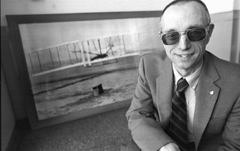
Dennis Bushnell is Chief Scientist at NASA's Langley Research Center. (Couresty of NASA/Langley Research Center)
Bushnell says CO2 is only part of the way airline travel contributes to global warming. The water vapor from planes is also a big problem because it forms extra clouds, which trap heat.
BUSHNELL: This is deposited at altitude where the predictions are that it’s like three to five times more important in terms of a global warming impact.
AHEARN: Three to five times more than if these gases were released at ground level.
Flying is also a big part of our personal carbon footprint. I wanted to see just how big, so I went to Al Gore’s carbon footprint calculator on the web.
AHEARN: [TYPING SOUNDS] Ok, so I probably drive about 2000 miles a year. And my average heating bill is 75-100; it’s been pretty cold lately. That puts me at 9 tons of carbon emitted per year.
So now lets see what happens if I fly. Let’s say I take three, no two short flights, that’s like flying to Florida I guess from Boston, and then we’ll say one medium flight. And then one long haul, not that I can afford to go to Europe on a regular basis, but you know, we’ll just put it in there for fun. That boosted my carbon by two tons per year.
AHEARN: So if I fly four times a year, my CO2 emissions go up by 22 percent.

(Courtesy of NASA)
ROCHAT: The technology is improving. Each new aircraft, new engine, is an improvement vis a vis the previous one. People are already working and considering this very long-term solution for aviation.
AHEARN: NASA’s Dennis Bushnell agrees major technological advancements are on the horizon, but he says the industry’s not moving fast enough to get there.
BUSHNELL: They’re talking about at the most 50% reductions in CO2 by evolutionarily fiddling around with the current machines and that will hardly account for the expected growth in air travel.
AHEARN: The number of tickets sold each year is set to double by 2025.
And when it comes to the possibility of replacing jet fuel, which is actually kerosene, with biofuel, there’s a bit of jet lag. Ethanol, for example, doesn’t pack as much energy as jet fuel, and biofuels tend to freeze at high altitudes.
In the European Union there’s a move to limit aircraft emissions by adding the airline industry to its carbon trading plan by 2011. But the airline industry says only a global solution would avoid putting certain carriers at a disadvantage.
ROCHAT: We believe that since aviation is a global industry and since airlines fly all over the world, only a global emissions trading scheme is able let’s say to cover all flights and to avoid discrimination, to avoid distortion of competition between airlines.
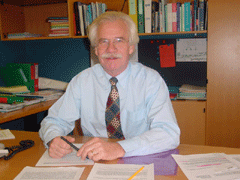
Phillipe Rochat is the Director of the Aviation Environment Department at the International Air Transport Association. (Courtesy of the International Air Transport Association)
AHEARN: Aviation emissions is now a major topic of debate in Europe. Politicians there and beyond, from Tony Blair to Arnold Schwarzenegger increasingly find themselves on the defensive over their frequent flights.
Some airlines have publicly responded. British Airways, Virgin-Atlantic, and Easyjet have committed to reducing their emissions and boosting fuel efficiency. But for some critics, that’s not fast enough and they’re taking matters into their own hands.
John Valentine is a stonemason from London. Last year he started a web campaign called flight pledge to get people to cut back on the amount of time they spend in the air.
VALENTINE: They log into the website and they make a pledge and in return for that promise the computer sends back a little certificate which they can print off and put on their toilet wall or whatever they want to do with it.
AHEARN: Valentine says he has more than 1500 members, most of whom are British. Not an international campaign perhaps, but it’s a gradual process.
VALENTINE: Then you’ve nibbled away at it, and I think just everybody has to make a wee bit of an effort. This is why the website doesn’t ask people to sort of forswear flying forever it says if you’re just going to do two flights a year, then that’s great.
AHEARN: For most of us, flying is still an unavoidable part of the way we get around. But for John Valentine’s next holiday in the South of France, he’ll be taking the train.
For Living on Earth, I’m Ashley Ahearn.
Related links:
- International Air Transport Association
- NASA - NASA's Langley Research Center
- John Valentine's website
A Chemical Conflict of Interest?

Marla Cone is an environmental writer with the Los Angeles Times.(Courtesy of Grove/Atlantic, Inc.)
GELLERMAN: It’s the job of the National Institute of Environmental Health Sciences to assess the potential dangers that chemicals pose to people’s reproductive health but that job is largely being done on behalf of the federal center by a private consulting firm called Sciences International.
Critics charge Sciences International’s federal contract creates a blatant conflict of interest. That’s because many of Sciences International private clients produce chemicals the company reviews for the government. One of the chemicals they’re now reviewing in a draft report is widely used in many consumer products. It’s called Bisphenol A or BPA and its safety is very controversial. Marla Cone is covering the story for the LA Times and joins us to help sort through the details.
Thanks, Marla.
CONE: Thank you.
GELLERMAN: You write that since 1998 Sciences International has been running this center for the evaluation of risk to human reproduction. And you say that their role is very unusual. How so?
CONE: Well it’s not unusual for a federal agency to have private contractors such as Sciences International. But it seems that what is unusual in this case is the extent of how much they do for this center. The Center is the agency that determines which chemicals pose a threat to human health, to human reproductive health. But what happens is that Sciences International is the first step. Its consultants write the first drafts of these reports. They collect all the data on a chemical and they put it into a report. Then the scientific review panel looks it over and makes conclusions. Sciences International also has what the Center calls an administrative role at the Center.

Marla Cone is an environmental writer with the Los Angeles Times. (Courtesy of Grove/Atlantic, Inc.)
GELLERMAN: But it also has, in its capacity as a private consulting company, some of the companies that it’s doing these reports on: Dow, Dupont, Union Carbide.
CONE: Yes, I have seen a client list of Sciences International. On its website it says that about half of its clients are private and the other ones are government agencies.
GELLERMAN: But many of the chemicals that those companies produce are the same ones that it’s doing these reviews for the government.
CONE: Right. On that list of clients was Dow chemical company, NBASF and they are both producers, or manufacturers of BPA, the chemical that they are now reviewing.
GELLERMAN: What about the conflict of interest or the apparent conflict of interest. Is anybody raising eyebrows about that?
CONE: Well, the National Toxicology Program, which runs this reproductive health center, is concerned. They’ve mounted an investigation. And they say they take the allegation of conflict of interest very seriously. They are now looking to see what types of policies the National Institute of Health has for contractors. They’re not sure if there is a conflict of interest policy and if there is whether it would apply to Sciences International.
GELLERMAN: The advocacy group Environmental Working Group, got a copy of a letter going back to 1999 from SI to R. J. Reynolds the tobacco maker, and, and they want to represent the tobacco company for the EPA over regulating a pesticide; and basically Sciences International is boasting about how they well, they’ve got a unique role both as a government contractor and a private firm and they can get the job done.
CONE: Right they were telling the tobacco company that what they can offer and what many other consulting companies can not offer on environmental issues is that they work for government. They work for these various agencies so they know what these agencies want.
GELLERMAN: Now that they’re issuing a report about this very contentious chemical, this widely used chemical, it’s called bisphenol A. And the government studies have shown that it has an effect, that it mimics estrogen. It can disrupt the delicate endocrine system. Yet none of the industry studies indicate there is an effect. Do you know what their draft report suggests?
CONE: Well, their draft report, the one that was initially written by Sciences International does not reach any conclusions. It does not say this is a reproductive toxin or this is not. What it does is it cites about 500 different studies and it gives a little bit of information about each. But some of the scientists I’ve talked to and Environmental Working Group have gone through it and what they say is it omits some data. It downplays some government studies at the same time as it gives a lot of information about some industry studies, that it has inaccuracies. So they say it’s sort of subtle what they think Sciences International did with the draft of its report.
GELLERMAN: Well, what happens now to that report?
CONE: That report, the panel met for two and a half days, but did not reach a conclusion. And I was told because of the extent and complexity of the data that it is taking more time to report on how serious the risk is from BPA will be out in two or three months.
GELLERMAN: I called Sciences International and they, you know, didn’t want to speak to me. They referred me to the NIH.
CONE: Right and that’s what they did for me too. They have refused to talk about it. They want the agencies to deal with that. The agencies as I said, now are mounting an investigation. They said that they are concerned about the industry ties. But they do not know if there is first of all a conflict of interest policy that this would apply to. I don’t know if there’s any consultants out there that just work for government and don’t take any industry money.
GELLERMAN: Well, Marla I want to thank you very much.
CONE: Thank you.
GELLERMAN: Marla Cone is an environmental reporter for the LA Times. Senator Barbara and Representative Henry Waxman are looking into potential conflicts of interest by Sciences International.
[MUSIC: Jenny Wilson “Hey, What’s The Matter” from ‘Love & Youth’ (Rabid Records – 2006)]
Related links:
- "Chemical agency ties under review" by Marla Cone 3/7/04
- Sciences International
- Environmental Working Group's coverage of Sciences International's involvement with the decision over bisphenol A
GELLERMAN: Coming up, rebirthing the baby business, an obstetrician re-thinks his profession. Keep listening to Living on Earth.
[MUSIC: Patty Larkin “Bound Brook” from ‘La Guitara: Gender Bending Strings’ (Vanguard Records – 2005 ]
Texas Fold 'Em?

Jennifer Krill is the Program Director for the Rainforest Action Network. (Photo: Rainforest Action Network)
GELLERMAN: It’s Living on Earth. I’m Bruce Gellerman. In the spirit of”if you can’t beat em join em” increasingly, large U.S. companies are cooperating with environmental groups on controversial projects.
The latest is the 38 billion dollar deal to acquire Texas energy company TXU. The firms mounting the buyout have teamed up with Natural Resources Defense Council and Environmental Defense and agreed to cut back on the number of coal burning power plants the company wants to build from eleven to three. But not all environmental groups are buying into the deal. Jennifer Krill is director of Rainforest Action Network’s climate change campaign and she joins us from the studios of KQED in San Francisco.
Jennifer, glad you’re here.
KRILL: Thanks so much.
GELLERMAN: So what’s your problem with the TXU deal?
KRILL: Well we think honestly that three plants are three coal fired power plants too many. We're thrilled, believe me, we're thrilled to see that eight plants are now off the table. The challenge for all of us now is to get rid of those remaining three power plants.

Jennifer Krill is the Program Director for the Rainforest Action Network. (Photo: Rainforest Action Network)
KRILL: Our primary focus at Rainforest Action Network is to get Wall Street to stop funding these proposals. The original TXU plant included an 11 billion dollar syndicated loan from a number of Wall Street firms. And the message that we're sending to Wall Street investors now, you know banks like Citigroup and Goldman Sacks and J P Morgan Chase, these banks hold the purse strings for the coal fired power plants that are being proposed in the United States today. We're telling Wall Street no new coal. It's time for Wall Street to write a new plan for America's energy future.
GELLERMAN: What does Rainforest Action Network plan to do if they do in fact get these three coal fired power plants built?
KRILL: Well, there's going to be a lot of campaigning that’s gonna take place between now and that happening and I think we've got a good chance of stopping those three power plants. Our focus is Wall Street. What we need is a transition to investments in energy efficiency, solar, and wind power. Ironically TXU is one of the top wind retailers in Texas and in fact in the entire country. So here with TXU you have a company that is both the problem and the solution. We need a little bit more of that solution. This is the twenty first century. We can't afford to keep building big boxes of coal to meet our energy needs. It's time to transition towards meeting our future energy needs with energy efficiency and renewables.
GELLERMAN: You know, Jennifer, wind is not without its opponents and not without its problems. There's what 5,000 megawatts of installed wind power in Texas. This Oak Grove coal plant will produce 1750 megawatts. You're going to need thousands of more wind turbines to replace that.
KRILL: The alternative to wind to be clear is 22 million tons of CO2 emissions annually, tons of annual emissions of mercury, local air pollutants, SOx, NOx, health problems for the people who live around those coal power plants. If you were to add all of the externalized costs of these coal fired power plants it would make wind seem much more appealing, and in Texas in particular it has been noted by energy experts from all around the world, there is a tremendous amount of untapped wind power potential. There's also untapped solar potential. And what's more there is a tremendous opportunity for energy efficiency. And you know what? Energy efficiency saves ratepayers money. And that's part of the reason that so many Texans are opposing these coal fired power plants. And in fact so many Texans oppose new coal in general.
GELLERMAN: Jennifer, this seems to be a water shed both in, um, the environmental movement and in the Wall Street finance backing of companies.
KRILL: We think it is a watershed moment. We think that in 2007 we're seeing the first nail in big coal's coffin.
GELLERMAN: Jennifer thank you very much.
KRILL: Thank you very much.
GELLERMAN: Jennifer Krill directs Rainforest Action Network’s climate change campaign. We also spoke with the Sierra Club about the TXU deal. You can hear their perspective. Go to our website l-o-e dot org.
[MUSIC: Thomas Leeb “The Winds Are Changing” from ‘Riddle’ (Thomas Leeb - 2005)]
Related links:
- Rainforest Action Network
- To hear an interview with David Hamilton, Director of the Sierra Club's Global Warming and Energy Program, click here.
A Bright Idea?

A compact florescent light-bulb. (Courtesy of Western Area Power Administration)
GELLERMAN: In 1857 French Physicist Alexandre Beqcquerel came up with the bright idea of the fluorescent bulb and today they’re the hottest thing in lighting or actually the coolest. Unlike incandescent bulbs--which generate a lot of heat and waste energy-- the latest version of fluorescent bulbs those compact, spirally looking ones are highly efficient.
[FLUORESCENT BULB ADVERTISEMENT]
There’s just one problem with compact fluorescent bulbs: they contain mercury which is toxic and when it winds up in the food chain, can cause damage to our brain, spinal cord, kidneys and liver. Joining me in the studio is Terri Goldberg. She’s Deputy Director of the Northeast Waste Management Officials Association.
Terri, thanks for coming in.
GOLDBERG: You're welcome. It's a pleasure to be here.
GELLERMAN: There's just a small amount of mercury in these compact florescent lights, right?
GOLDBERG: That's correct. The amount will depend on the wattage of the bulb and the size of the bulb. So there's more mercury in larger bulbs and higher wattages.
GELLERMAN: Now until recently most of the florescent lights we've used have been in industrial places, you know these long thin ones.
GOLDBERG: That's right linear, they're called linear florescent lamps. Typically you see the four foot ones in fixtures, in all office buildings now, are lighted by florescent lamps. Or you see them in hospitals, schools, as you said industrial locations, everywhere. They're all over the place.

A compact florescent light-bulb. (Courtesy of Western Area Power Administration)
GOLDBERG: That's right. They're becoming much more accessible to the consumer. Households are beginning to purchase them more and more because the price has come down and because of the energy efficiency advantages that they have.
GELLERMAN: I know that according to some industry groups there are about 700 million of these bulbs are being sold and only a small fraction are actually being recycled for the mercury content.
GOLDBERG: Yes, my understanding from the data that we've seen, we're seeing recycling rates for florescent lamps on the order of 20 to 25 percent of the lamps are being recycled in the US currently. Most of those, as I understand it, are the linear florescent lamps. Those are the more wide spread lamps that you see. And from a regulatory point of view there's no regulations related to waste generated by house holds accept for a local jurisdiction or a state jurisdiction. So, the vast majority of incandescent lamps are used for industrial or commercial settings. And so the target has been to increase recycling by those entities.
GELLERMAN: So what does the average person do? They go to the store with the best of green intentions. They buy some of these curly cue little bulbs and they feel good about it. And then it comes time to get rid of them and it's not okay just to toss them in the trash.
GOLDBERG: Legally, in most jurisdictions you can throw them in the trash if you're in a household setting.
GELLERMAN: Is that kind of an ecological no no though?
GOLDBERG: Yes, we recommend that people recycle these bulbs.
GELLERMAN: And where would I bring my bulbs? I mean that's a little onerous. You know I've got to accumulate my bulbs. Remember that those are the used ones as opposed to the new bulbs.
GOLDBERG: That's true it is a burden on the consumers and residents. And it depends on where you live what you can do with them. In locations where you have, say household hazardous waste collection programs some of those programs take these lamps back. Or you might be able to do it through say a Department of Public Works if they collect household hazardous wastes. But it's only in very few locations where the retailer is now involved in taking back these florescent lamps, like you have with the bottle bill. So for example in Vermont we're now seeing True Value Hardware stores, Ace Hardware stores beginning to provide this as a service to their customers. But we haven't yet seen that with Walmart or Home Depot or other large retailers of these products.
GELLERMAN: It's a real patchwork.
GOLDBERG: That's right and that's a huge challenge.
GELLERMAN: Well Walmart, really is pushing these bulbs, they want to sell one compact florescent bulb to each one of their hundred million customers this coming year.
GOLDBERG: That's right and as I understand it there's beginning to be discussions with Walmart about this problem for their customers of what to do with these bulbs when they burn out.
GELLERMAN: Is there really a benefit after all is said and done of using compact florescent bulbs as opposed to incandescent bulbs? I'm thinking of the mercury in the environment because coal power plants produce mercury.
GOLDBERG: That's right coal fired power plants emit mercury because there's trace amounts of mercury in the coal and they're burning millions of tons of coal and that gets released to the atmosphere. And I guess I would rather than see it as one or the other we really want to see people doing both. We want to see people buying and using energy efficient lighting and we want to see them be able to manage the lamps at the end of life correctly. We want to see them recycle these things so that both sources of mercury are being reduced. And I think as customers we need to begin to, more and more, engage our local authorities, state authorities, and at the federal level in this conversation about expanding the recycling and collection of these products at the end of their life.
GELLERMAN: Well, Terri Goldberg thank you very much for coming in.
GOLDBERG: Well, I appreciate the opportunity. Thank you.
GELLERMAN: Terri Goldberg is deputy director of the Northeast Waste Management Officials Association.
[MUSIC: The Slip “Sorry” from ‘Angels Come On Time’ (Rykodisc – 2006)]
Related link:
Northeast Waste Management Officials' Association
Born in the U.S.A.
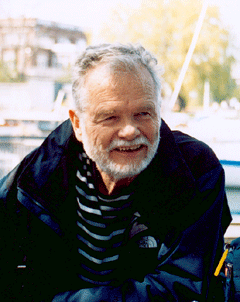
Dr. Marsden Wagner (Courtesy of Dr. Marsden Wagner)
GELLERMAN: For most of his career Dr. Marsden Wagner was your typical American OB/GYN. A baby doctor; delivering his share of the four million babies that are born each year in the United States.
Ninety-nine percent of those births take place in hospitals. That’s the way it should be, thought Dr. Wagner until he became the Director of Women and Children’s Health at the World Health Organization and began to travel to places where midwives do the job.
What he saw changed his life.
WAGNER: And it was an epiphany for me it was a shock beyond belief because that woman when she got near birth she started yelling and she said to the midwife and to me and the family and everybody, “Stand back, I’m gonna have this baby!” And she did. And what I actually witnessed for the first time in my life was a woman in her full power, and it scared me to death.

Dr. Marsden Wagner (Courtesy of Dr. Marsden Wagner)
GELLERMAN: The idea that midwives could do in the home what doctors did in hospitals only cheaper and better in terms of the health of babies and moms led Dr. Marsden Wagner to re-think his profession and write the book “Born in the USA- How a Broken Maternity System Must Be Fixed to Put Women and Children First.”
WAGNER: It's important to know that midwifery is a profession that goes back into antiquity. The word midwife comes from the ancient English for "with the woman." In Danish it is jordemor, which means “earth mother”. And there have always been women at birth. Birth was part of the women's world.
GELLERMAN: I gotta tell you. I'm a little bit um hesitant about this interview because here we are two men talking about women, maternity, and birth.
WAGNER: Well, I think that's a very legitimate concern. And indeed until about 250 years ago there were never any men at the birth. And indeed one of the best known early obstetricians in Great Britain went to birth cross dressed as a woman.
GELLERMAN: Well, I did read your book with great interest and basically what I understand you to be saying is that we've got a broken system. The maternity system in the United States, the way kids are born here is broken. Well, what's the problem?
WAGNER: Well, the problem is that the obstetric profession 100 years ago decided to drive out the midwives because they were taking their patients. And they wanted the field to themselves. So they started campaigns in many states, witch-hunts essentially, to claim that midwives don't know what they're doing. They're killing babies and so forth. And they succeeded in driving midwifery out of our country. They didn't do that in any other country. And in every country in the world, except ours, highly trained midwives catch the vast majority of babies except for the 10 or 15 percent where there's a serious medical problem. But in our country the obstetricians try to catch all the babies and get all the money and all the credit. And this is a very broken way to do things. We have good scientific data showing that doing it this way means many more dead women and many more dead babies.
GELLERMAN: So what you're saying is that they've turned the maternity system into a medical system.
WAGNER: Exactly. It's turning birth into a surgical procedure. And since obstetricians are also gynecologists it means they're also surgeons. So they do it as a surgical procedure. But it is Mickey Mouse and it has nothing to do with the safety of that birth.
GELLERMAN: Well, there have been a dramatic increase in the number of surgical procedures during birth, c-section. But you write basically it stands for convenience. It’s for the convenience of the doctors.
WAGNER: Well you see the problem for the busy gynecologist obstetrician is, that he or she has far too much to do. In catching all the babies, and doing all the family planning, and doing all of the gynecological surgery; their plate is over flowing. And the worst thing on their plate is normal birth because it takes, on average 12 or more hours, and it happens 24/7. So it is a nightmare yet it is their primary source of income. So they're not gonna give it up. So what they've got to do is bring it under control. Now there are two ways that, ah, the obstetrician can bring control into childbirth.
One is to artificially start the labor at a time that is convenient to the doctor and the hospital. And this is done through induction of labor with very powerful drugs. Now the second way that you can bring control into this is to do a cesarean section instead of a normal birth because a cesarean section takes 20 minutes not 12 hours and I can schedule it. And, as a matter of fact, we do twice as many caesarians in this country as should be done. It is more dangerous for the woman and it is more dangerous for the baby.
GELLERMAN: One of the drugs that is used to induce labor is something called cytotec and you talk about it in the book.
WAGNER: The amazing thing about cytotec is that it is on the market only to treat stomach ulcers in adults. And it says on the bottle that this should never be used on pregnant and birthing women. And in fact there's a picture on the bottle of a silhouette of a pregnant woman with a line through it. And yet they use this to induce labor. And the, the result is that this drug causes such violent contractions of the uterus that the baby can't get enough oxygen because the only time a baby gets oxygen during labor is in between contractions.
GELLERMAN: But if you go to the website of the American College of Obstetricians and Gynecologists, which I did, they say, "Yes we have a crisis in the United States in terms of OB/GYN and birthing. The fact is we don't have enough OB/GYNs and that docs are starting to get out of the business because they're afraid of being sued because it's the riskiest of all the specialties in terms of law suits.
WAGNER: Well, there is a great deal of litigation against obstetricians in our country and the obstetricians are screaming and screaming, "no, no, no" and yet why is there all of this litigation? It's because when the woman, pregnant woman, comes to the obstetrician basically the obstetrician is saying, "You come to me and all my expertise and the beautiful hospital with all their machinery and we will guarantee you a beautiful perfect baby." Well, if you play God you get blamed for the natural disasters.
GELLERMAN: You're very passionate Dr. Wagner. Um, are you optimistic?
WAGNER: Yes, I am optimistic. And I'm optimistic because I believe Abe Lincoln was right you can't fool all the people all the time. The American public is going to wake up and discover, for example that the obstetricians are absent, and discover that we're not number one in the world when it comes to maternity care. And discover that we're paying twice as much as we need to for the maternity care. And discover that they are being deprived of this wonderful professional called a midwife and so forth. And they are going to wake up.
GELLERMAN: Well, Dr. Wagner thank you very much. It's been a pleasure talking with you.
WAGNER: Thank you very much sir.
GELLERMAN: Dr. Marsden Wagner's new book is called "Born in the USA: How a Broken Maternity System Must be Fixed to Put Women and Children First."
[MUSIC: Happy Baby “Rock-A-Bye-Baby” from ‘Happy Baby: Good Night’ (Valley Entertainment – 1999)]
Related links:
- Dr. Marsden Wagner's website
- "Born in the U.S.A: How a broken maternity system must be fixed to put women and children first"
- American College of Obstetricians and Gynecologists
GELLERMAN: Just ahead: red light, green light, 1-2-3. Arizona makes highway crosswalks for wildlife. Take a walk on the wild side and keep listening to Living on Earth.
ANNOUNCER: Support for the Environmental Health Desk at Living on Earth comes from the Cedar Tree Foundation. Support also comes from the Richard and Rhoda Goldman Fund for coverage of population and the environment, and from you our listeners and from member stations. This is Living on Earth on PRI- Public Radio International.
[MUSIC: Snooze “It’s More Expensive For This” from ‘Going Mobile’ (Crammed Discs – 2001)]
The Language of Landscape
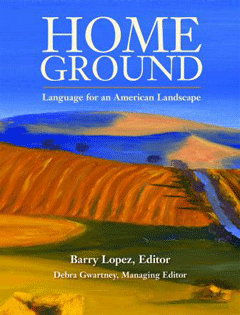
Home Ground: Language for an American Landscape, edited by Barry Lopez and Debra Gwartney. (Courtesy of Trinity University Press)
GELLERMAN: It’s Living on Earth. I’m Bruce Gellerman. Just ahead it sounds a little cuckoo a painting brings music to the ears of bird scientists. But first, we begin a new series on Living on Earth called “Home Ground.”
[MUSIC: Daniel Lanois “O Marie” from ‘Arcadie’ (Daniellanois.com - 2005)]
GELLERMAN: Can you really say you know a place, I mean really know a place, until you can describe the landscape the pattern of folds and features that make a place unique? Learning to describe a landscape is part of making it our own, claiming it as a place we care about.
Nature writer Barry Lopez has devoted his life to describing landscapes in intimate detail. So he was surprised to find not long ago, that no one had ever published a dictionary of American landscape terms. So Lopez and fellow writer Debra Gwartney set out to do just that.
They asked 45 other writers to craft accurate—but lyrical—definitions of landscape features they know and love, ranging from the commonplace like “field” and “desert” to the obscure like: “ganderbrush”, “hogback ridge”, and “witness tree”.
The result is a new collection called Home Ground: Language for an American Landscape. And over the next few months, we’ll feature a series of entries from the book, read by the authors.

Home Ground: Language for an American Landscape, edited by Barry Lopez and Debra Gwartney. (Courtesy of Trinity University Press)
We begin this week with Oregon writer John Daniel reading his definition of one of the signature landscape features of his part of the country: “Cascade”.
DANIEL: Cascade. Mountain streams like to descend in stair step series of short falls and brief pools. In these cascades water alternates between two energy states. Much like air shifting between super and subsonic flow. The white water of the falls is the fluvial equivalent of a sonic boom. Cascade is used more broadly to mean a rocky stretch of white water less steep than a waterfall but steeper than a rapid.
The cascades of the Columbia River formed several centuries ago when a massive slide filled a channel in the mid Columbia Gorge presented Louis and Clark’s core of discovery with a three miles stretch of chutes and falls boiling in a most horrible manner, according to William Clark’s journal.
Rafting or boating the gorge was the last leg of the Oregon Trail for many early immigrants. Some lost all they owned to the Cascades and some lost their lives. Now drowned in slack water behind Bonneville Dam this reach of river gave the Cascade Range its name.
[MUSIC: Don Williams “Till The Rivers All Run Dry” from ‘Don Williams: Anthology’ (UMG Recordings – 2000)]
GELLERMAN: John Daniel lives and writes in the hills just outside of Eugene, Oregon. His definition of “Cascade” is included in the new book Home Ground: Language for an American Landscape, edited by Barry Lopez and Debra Gwartney. In the coming weeks, we’ll hear other entries from the book including definitions of such landscape features as: “Blind Creek”, “Kiss Tank”, and “Anchor Ice”.
Related links:
- Home Ground: Language for an American Landscape
- John Daniel's website
Wildlife Crossings

Highway 260 just east of Payson, Arizona. (Arizona Game and Fish Department.)
GELLERMAN: Arizona is the fastest growing state in the country. More people means more of everything, including encounters between humans and wildlife. In Payson, a small town in northern Arizona, state officials have created an innovative way to reduce collisions between cars and animals.
Arizona Public Radio’s Gillian Ferris Kohl reports.
KOHL: It can be an upsetting experience to run over a squirrel as it skitters off the road. But it’s a different experience altogether when a six hundred pound elk comes crashing through your windshield.
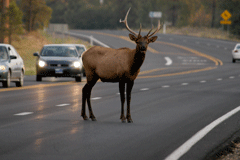
Highway 260 just east of Payson, Arizona.(Arizona Game and Fish Department.)
KOHL: That’s Bob Tusso, a hydrogeologist from Flagstaff. He hit and killed an elk last year, driving seventy five miles an hour. Tusso says she was as big as his Subaru.
TUSSO: Her body hit about at the top of the windshield and smashed it where it connects to the roof. If you see pictures of the car, it looks like somebody got totally flattened in there. They had to cut off the roof, put on a new windshield, a new hood. I still find pieces of elk, or elk hair in the upholstery and whatever when I clean out the car.
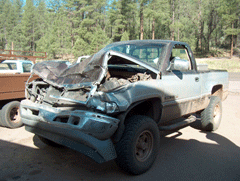
A truck destroyed by an elk collision on Highway 260 just east of Payson, Arizona. (Arizona Game and Fish Department.)
[SOUNDS OF THE HIGHWAY]
KOHL: Highway 260 outside of Payson has a particularly high accident rate. Like many Arizona highways, it has only two lanes and winds through mountainous terrain with plenty of blind corners and sheer drop-offs. Researchers here are conducting an experiment to teach drivers – and animals – to, essentially, “look both ways.” On this cold morning, Jay Vagalatos stands on the side of Highway 260 in front of an open metal shed full of computers.
VAGALATOS: Basically, what we have up there two thermal cameras which are aimed at the detection zones. We don’t want squirrels settin’ em off. We kind of want large hot objects like humans or elk, deer, possibly even like a large mountain lion would set it off but that’s a good thing too.
KOHL: Vagalatos designed the software for the wildlife crosswalk. The animals are routed to the crossing by a series of low-voltage electrified fences. Then the computers send a real time warning to drivers that large animals are close by.
VAGALATOS: What it does.. It’ll send a signal to a radio. It fires off the flashers sends another radio signal to the message boards which fire off a message that say “elk detected. Slow Down”
KOHL: Yellow-flashing lights force a driver’s immediate attention to the road. Vagalatos believes the system is much more effective than roadside signs like those warning drivers to watch for elk for the next forty miles.

Elk crosswalk warning signs on Highway 260 just east of Payson, Arizona. (Arizona Game and Fish Department)
KOHL: The Arizona Game and Fish Department is pleased with the results. Norris Dodd is project coordinator.
DODD: Lo’ and behold, in the year after they fenced, the collision rate went down eighty three percent so really the net result is we’re making not only a highway that’s better for people and safer but better for animals.
KOHL: And, 11 new underpasses give the animals additional places to cross the highway. But, Dodd says, the success of the project ultimately depends on drivers.

Highway 260 just east of Payson, Arizona.
(Arizona Game and Fish Department.)
DODD: In one two-day period, we had 136 vehicles going over 105 miles an hour and this is an area posted at 55 miles per hour. Sometimes I kind of promote the notion that we oughta leave all the dead animals on the side of the road so all the people will get the visual clue that maybe they need to slow down.
[JINGLING BELL SOUNDS]
KOHL: Much of the data for the project is collected by the animals themselves.
KOHL: Dodd has trapped more than a hundred elk and outfitted them with GPS data collection collars.
[ELK BARKING]
KOHL: The collars track the elks’ migration patterns, including how many times they cross or even come close to the highway. This morning, Dodd finds a female yearling in one of the traps. He and his crew blind fold her and put on her thick necklace.
[SOUNDS OF TAGGING ELK AND ELK BARKING]
KOHL: The elk will wear the collar for 22 months when a pre-set explosive charge will blow it off her. Game and Fish researchers will use the data to continue work on this highway and elsewhere in Arizona. Canada and Michigan are conducting similar experiments.
For Living on Earth, I’m Gillian Ferris Kohl, in Payson, Arizona.
Related link:
Arizona Game and Fish Department
Sumatran Cuckoo Breaks Its Silence
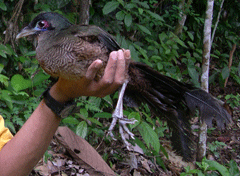
The Sumatran Ground Cuckoo. (Courtesy of Wildlife Conservation Society)
GELLERMAN: The devastating earthquake that recently struck Indonesia is only the latest in a long list of disasters to hit the region. In 2004, a tsunami killed hundreds of thousands of people and since then the Asian Archipelago has been plagued with floods, volcanic eruptions, landslides, dengue fever, and bird flu.
But amid all the grim news is one small but noteworthy event: a team of biologists on the island of Sumatra in Indonesia have recorded for the very first time the call of one of the world’s rarest and most secretive birds: the Sumatran Ground Cuckoo.
Joining me is Peter Clyne assistant director of the Asia program at the Wildlife Conservation Society. Hi, Peter.
CLYNE: Hi Bruce.
GELLERMAN: This bird was thought to be extinct in 1916 and then one was found in 1998. How did your scientists come across the Sumatran Ground Cuckoo?
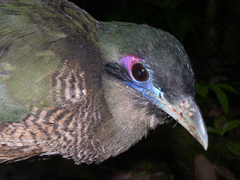
Ground Cuckoo head (Courtesy of Wildlife Conservation Society)
GELLERMAN: So you got the bird.
CLYNE: Yeah, we got the bird. It was early in January of this year. Sure enough basically a hunter from the northern part of Bukit Baresan Selatan National Park called up one of our biologists. His name is Sirdaus Raman and Daus instantly got on a bus and traveled for eight hours to this really remote village and sure enough there it was.
GELLERMAN: And he identified it right away?
CLYNE: Oh yes.
GELLERMAN: It’s very distinctive looking I guess, huh?
CLYNE: It’s very distinctive. It’s about a foot and a half long. It’s got a dark iridescent green back, sort of a rufus red bard underbelly and it’s got a beautiful blue and purple bare patch around the eye. And he spent the night next to the bird with his cell phone recorder in hand hoping to get a recording of the call and that was actually the first recording that we got.

The Sumatran Ground Cuckoo. (Courtesy of Wildlife Conservation Society)
GELLERMAN: Well, I understand we have gotten from you a copy of this call. Let’s listen to it ok?
CLYNE: Ok
[BIRD CALL]
GELLERMAN: Well, that’s not exactly music to my ears.
[BIRD CALL]
CLYNE: I kind of laugh at the song because, ah you know, it’s basically not been known for well 150 years. It finally breaks its silence and it sounds a bit like a chicken running scared or something and that makes me laugh.
GELLERMAN: Why do you want the sounds of the Sumatran Cuckoo in any event?
CLYNE: Well, for a variety of reasons. First because it’s never been noted before, this is of course new information to science which is great. Second we are hopeful that we will be able to use this call to go out into the woods, play it out there, and we hope that other birds will respond to this call. And this is exactly what’s happened with a sister species called the Borneo Ground Cuckoo. Ornithologists went out, used that recording, the birds would respond to that call. So then they got a much better sense for the distribution of the Borneo Ground Cuckoo.
GELLERMAN: Peter, what caused, um this bird to be near extinct?
CLYNE: I think it’s a bit premature to call it nearly extinct. It’s a very very secretive bird and probably a very rare bird. This bird is thought to be found in mountain forests of Sumatra and those are under threat because of conversion to coffee plantations. And this bird may also be found in lowland forests. We’re not sure of that. We’re certainly hoping to find out. The lowland forest of Sumatra is under tremendous threat to conversion to palm oil plantations.
GELLERMAN: Peter before I say bye to you let’s listen to the Sumatran Ground Cuckoo one last time.
[BIRD CALL]
GELLERMAN: Boy that is some sound isn’t it.
CLYNE: It really fills us with a lot of hope and pride actually.
GELLERMAN: Really, why’s that?
CLYNE: Well, you know the Borneo Ground Cuckoo story is a pretty good parallel. And the song really did enable people to go out there and find out quite a bit more about it. And so we’re hopeful that this is going to be the case here too, that there are going to be quite a bit more of the birds than we thought. And hopefully we can show that they’re not actually critically endangered. That’s certainly what we hope so.
GELLERMAN: Peter Clyne is assistant director of the Asia program at the Wildlife Conservation Society, which recorded the song of the rare Sumatran Ground Cuckoo. Peter thank you very much.
CLYNE: Thank you.
Related link:
Wildlife Conservation Society's website for the Sumatra Ground Cuckoo
Return of the Tibetan Antelope
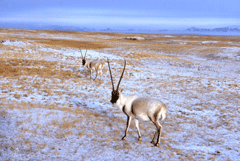
The Tibetan antelope or chiru. (Photo: George Schaller/Wildlife Conservation Society)
GELLERMAN: The Chang Tang is a rolling upland that stretches across the northern part of the Tibetan Plateau in China. It’s one of the least-known places on earth, a sweeping wilderness 16,000 feet high, punctuated with glacial peaks. Field biologist, George Schaller, has been studying this region for more than 20 years.
You might be familiar with his world-famous research on Mountain Gorillas of Central Africa, the lions of the Serengeti, the snow leopards of Nepal, and the pandas of Wolong, China. Now 73, the intrepid Dr. Schaller’s most recent expedition took him to the Chang Tang again, this time in search of another creature, the Tibetan Antelope, or Chiru.

The Tibetan antelope or chiru. (Photo: George Schaller/Wildlife Conservation Society)
But Chiru have one disadvantage: they have the finest wool in the world. During the late 1980s and 1990s they were mass-slaughtered by poachers who sold the wool to India to make shahtoosh shawls for the world’s luxury market. Fortunately this illegal trade has now been much reduced. Indeed in some areas, Chiru seem to be on the increase again.
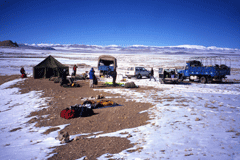
A typical field camp during the traverse. (Photo: George Schaller/Wildlife Conservation Society)
This winter our team of fourteen Tibetan and Han Chinese and I made a great traverse of the region. We drove a thousand miles cross-country without seeing another person. It was cold, getting down to 25 below zero at night, and a fierce wind often swept over the landscape. But in this seemingly barren country we were surprised by how much wildlife we encountered and were delighted to count about 8,000 Chiru. It was a hopeful sign for the future. We also saw a thousand wild yaks, an animal much more rare than a Chiru. We recorded 22 wolves, several had probably never seen a person before. They showed little fear, and one even visited camp.
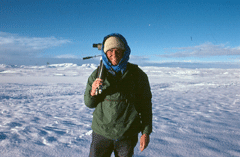
Dr. George Schaller. (Photo: Wildlife Conservation Society)
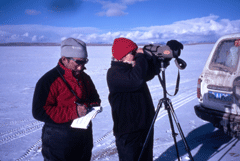
A few members of the field team looking for wildlife. (Photo: George Schaller/Wildlife Conservation Society)
GELLERMAN: Dr. George Schaller’s research trip was funded by the National Geographic Society and the Wildlife Conservation Society. To see photos of his expedition to the Chang Tang, including one of the Tibetan antelope, trek to our website, l-o-e dot org.
[MUSIC: Mum “Asleep In A Hiding Place” from ‘Kitchen Motors Family Album’ (Kitchen Motors – 2007)]
Related links:
- Wildlife Conservation Society
- To read "The Great Chang Tang Traverse" by George Schaller click here.
GELLERMAN: Next week on Living on Earth.
[BABOON SOUNDS]
GELLERMAN: “They’re hungry, and hairy, and clearing out the fridge” according to a recent newspaper headline in South Africa, adventurous baboons are getting too close for comfort.
JAMES: They’re not domestic animals. It’s not like having a cat or a dog. A baboon is a wild animal. And he, and he lives accordingly. And if you get in his way and you corner a big male, he’s going to go for you.
GELLERMAN: Battling baboons on the streets of Cape Town, next week on Living on Earth.
GELLERMAN: Living on Earth is produced by the World Media Foundation. Our crew includes Ashley Ahearn, Eileen Bolinsky, Ian Gray, Ingrid Lobet, Emily Taylor, Peter Thomson and Jeff Young - with help from Bobby Bascomb, and Kelley Cronin. Our interns are Paige Doughty and Meghan Vigeant. Dennis Foley is our technical director. Alison Lirish Dean composed our themes. Our executive producer is Steve Curwood. You can find us at l-o-e dot org. I’m Bruce Gellerman. Thanks for listening.
ANNOUNCER: Funding for Living on Earth comes from the National Science Foundation, supporting coverage of emerging science. And Stonyfield Farm Organic yogurt and smoothies. Stonyfield pays its farmers not to use artificial growth hormones on their cows. Details at Stonyfield dot com.
Support also comes from you our listeners, the Ford Foundation, the Educational Foundation of America and the Saunders Hotel Group of Boston's Lennox and Copley Square Hotels. Serving you and the environment while helping preserve the past and protect the future, 800-225-7676.
Living on Earth wants to hear from you!
Living on Earth
62 Calef Highway, Suite 212
Lee, NH 03861
Telephone: 617-287-4121
E-mail: comments@loe.org
Newsletter [Click here]
Donate to Living on Earth!
Living on Earth is an independent media program and relies entirely on contributions from listeners and institutions supporting public service. Please donate now to preserve an independent environmental voice.
NewsletterLiving on Earth offers a weekly delivery of the show's rundown to your mailbox. Sign up for our newsletter today!
 Sailors For The Sea: Be the change you want to sea.
Sailors For The Sea: Be the change you want to sea.
 The Grantham Foundation for the Protection of the Environment: Committed to protecting and improving the health of the global environment.
The Grantham Foundation for the Protection of the Environment: Committed to protecting and improving the health of the global environment.
 Contribute to Living on Earth and receive, as our gift to you, an archival print of one of Mark Seth Lender's extraordinary wildlife photographs. Follow the link to see Mark's current collection of photographs.
Contribute to Living on Earth and receive, as our gift to you, an archival print of one of Mark Seth Lender's extraordinary wildlife photographs. Follow the link to see Mark's current collection of photographs.
 Buy a signed copy of Mark Seth Lender's book Smeagull the Seagull & support Living on Earth
Buy a signed copy of Mark Seth Lender's book Smeagull the Seagull & support Living on Earth

